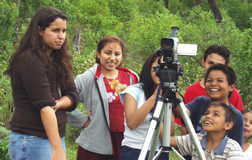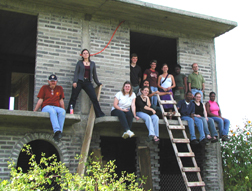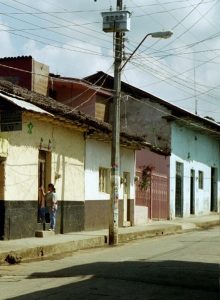 Dickinson students have also had the opportunity to pick apples in the Adams County orchards, visit migrant worker camps, teach ESL in school classes and after-school programs, work with the health clinics, and interview growers and advocacy groups in Adams County. In Peribán, students are involved in ethnographic fieldwork and interviewing families of migrant workers and people who have settled in Adams County. They have also danced the night away at fiestas, visited the cemeteries during the Day of the Dead, interviewed health care experts, educators, owners of tacquerias and tortillerias, and had lots of conversations with people who have crossed the border to work in El Norte. The one group of 10 students who have been in Peribán for the month of November will soon be joined by the second group of 11 students who will be spending a week there at the end of the month.
Dickinson students have also had the opportunity to pick apples in the Adams County orchards, visit migrant worker camps, teach ESL in school classes and after-school programs, work with the health clinics, and interview growers and advocacy groups in Adams County. In Peribán, students are involved in ethnographic fieldwork and interviewing families of migrant workers and people who have settled in Adams County. They have also danced the night away at fiestas, visited the cemeteries during the Day of the Dead, interviewed health care experts, educators, owners of tacquerias and tortillerias, and had lots of conversations with people who have crossed the border to work in El Norte. The one group of 10 students who have been in Peribán for the month of November will soon be joined by the second group of 11 students who will be spending a week there at the end of the month.
“The reception has been amazing,” said Susan Rose, a sociologist and one of the 3 faculty members directing the Mosaic along with Professors Marcelo Borges (History) and Kjell Enge (Anthropology). People have been very warm and welcoming, willing to open their homes and share their lives with us. “It has been a remarkable experience. In the first week in Peribán we were invited to have a meal with at least 5 families – all 14 of us!” All of the families – and virtually everyone we have met – has either worked in the United States at one point in time, or has a family member who works in the U.S. now. Since Peribán is off the tourist track, we are very noticeable, but people have been very open – in part because people have friends and family who work and live in the United States. Peribán de Ramos, surrounded by avocado orchards and with a lively plaza, is also a beautiful mountain town of some 11,000 inhabitants.
 We decided to go to Peribán because the majority of people in York Springs, Pennsylvania come from there. Kjell Enge and the 1998 Mexican Mosaic students first discovered that when they looked at the records of money orders sent from local stores to Mexico. Remittances sent from the U.S. back to hometowns is a major source of income and the majority of the money orders were sent to Peribán de Ramos. So Enge and Rose took a scouting tour to see if there was a possibility of students spending some time in Peribán to study further the dynamics and impacts of circular migration on both the sending and receiving countries – and on the individuals and families who move between both communities.
We decided to go to Peribán because the majority of people in York Springs, Pennsylvania come from there. Kjell Enge and the 1998 Mexican Mosaic students first discovered that when they looked at the records of money orders sent from local stores to Mexico. Remittances sent from the U.S. back to hometowns is a major source of income and the majority of the money orders were sent to Peribán de Ramos. So Enge and Rose took a scouting tour to see if there was a possibility of students spending some time in Peribán to study further the dynamics and impacts of circular migration on both the sending and receiving countries – and on the individuals and families who move between both communities.
Adams County lies some 18 miles from Dickinson’s campus, and was host to the Dickinson’s 1998 American Mosaic. It has long been one of the most productive fruit growing regions in the United States. Local growers of apples, peaches, pears, and other orchard fruits have historically depended upon migrant worker to pick their crops cheaply and efficiently throughout the region. In recent years, laborers have come from outside the United States, mostly migrating north from Mexico. Many of them come from villages in the state of Michoacán, not far from Querétaro, Dickinson’s partner site for international programs in Mexico.
 Many of the Mexican migrant workers have decided to settle permanently in the small towns that dot the county, particularly in municipalities such as Biglersville, York Springs, and Gettysburg. These permanent residents are in the process of establishing a Mexican-American community in Adams County, a development that has introduced the region to new degrees of linguistic, racial, religious, and cultural diversity. For this reason, the region provides a rich site for students interested in learning about ethnicity and multiculturalism in the United States. According to the U.S. Census data, there were 1,216 Hispanics in Adams County in 1990 and almost triple that number in 2000 with 3,323 persons of Hispanic or Latino origin. While 95.4 percent of the Adams County population is white, 3.6 percent is Hispanic or Latino. Of this 3.6%, seventy-two percent (2,366) are of Mexican origin.
Many of the Mexican migrant workers have decided to settle permanently in the small towns that dot the county, particularly in municipalities such as Biglersville, York Springs, and Gettysburg. These permanent residents are in the process of establishing a Mexican-American community in Adams County, a development that has introduced the region to new degrees of linguistic, racial, religious, and cultural diversity. For this reason, the region provides a rich site for students interested in learning about ethnicity and multiculturalism in the United States. According to the U.S. Census data, there were 1,216 Hispanics in Adams County in 1990 and almost triple that number in 2000 with 3,323 persons of Hispanic or Latino origin. While 95.4 percent of the Adams County population is white, 3.6 percent is Hispanic or Latino. Of this 3.6%, seventy-two percent (2,366) are of Mexican origin.
Students in the Mosaics, which involve interdisciplinary fieldwork, take all four courses together with 3 faculty during the semester. This enables everyone to really delve into the academic areas needed to prepare students for fieldwork and for an understanding of the culture and history which they are about to encounter. This is very important for interviewing – the more one knows about the context within which people’s lives are lived – the better the interview. Not only do students develop a variety of valuable skills through the Mosaic, so do the faculty who are working cooperatively with one another. Ashley Finley, a new professor in Sociology, was hired to teach, among other courses, quantitative methods. Her dissertation research focused on inequality and resource allocation and use among female-headed households in Mexico. This Mosaic provided a wonderful opportunity for students to see the triangulation of research methods and data collection in action – with faculty learning from one another and in collaboration with students.
As Prof. Finley writes:
 Contemporary sociologist, Peter Berger, once stated, “One can be an excellent physicist without ever stepping outside of one’s society; I know this is not so for a sociologist.” Having just returned from seeing the first week of Mosaic fieldwork in Peribán de Ramos, Mexico, I am acutely aware of the significance in Berger’s statement. Through interactions, shared meals, and simple salutations, I have learned that even the subtlest partings with American culture can widen the scope of the sociological imagination. Early meetings with Mexican families revealed that borders do more than separate land, they separate our emphasis on kinship networks, acceptance of strangers, generosity of time, and capacity to share even the most limited resources.
Contemporary sociologist, Peter Berger, once stated, “One can be an excellent physicist without ever stepping outside of one’s society; I know this is not so for a sociologist.” Having just returned from seeing the first week of Mosaic fieldwork in Peribán de Ramos, Mexico, I am acutely aware of the significance in Berger’s statement. Through interactions, shared meals, and simple salutations, I have learned that even the subtlest partings with American culture can widen the scope of the sociological imagination. Early meetings with Mexican families revealed that borders do more than separate land, they separate our emphasis on kinship networks, acceptance of strangers, generosity of time, and capacity to share even the most limited resources.
Like many of the students in the Mosaic, I am new to the methodologies of fieldwork. In my research, people are subsumed by the numbers and categories they represent. Though such quantitative analyses are important, I now have a sense of the colorful detail that lies somewhere between the black and white of numbers. Each completed interview and established contact in Peribán will do more than reveal the nature of migration, it will begin to strike at the cultural nuances surrounding this issue. And that is good social science. Rarely do undergraduate students have the opportunity to engage in real social scientific research the way that this group of Dickinson students will do over the next few weeks. After being a part of this collective effort, I have no doubt that the 2003 Mexican Mosaic will emerge with data and insights worthy of true academic pause. I may not go as far as to say that the experience of stepping into the streets and homes of Peribán de Ramos has made me an excellent sociologist, but it has certainly made me a better one.